Balbharti Maharashtra State Board Class 10 History Solutions Chapter 6 Entertainment and History Notes, Textbook Exercise Important Questions and Answers.
Std 10 History Chapter 6 Question Answer Entertainment and History Maharashtra Board
Class 10 History Chapter 6 Entertainment and History Question Answer Maharashtra Board
History Class 10 Chapter 6 Question Answer Maharashtra Board
Question 1.
(A) Choose the correct option from the given options and complete the statement.
(1) ……… are supposed to be the first keertankar in Maharashtra.
(a) Saint Dnyanehshwar
(b) Saint Tukaram
(c) Saint Namdev
(d) Saint Eknath
Answer:
(c) Saint Namdev
![]()
(2) Baburao painter made the movie, …………………….. .
(a) Pundalik
(b) Raja Harischandra
(c) Sairandhri
(d) Bajirao-Mastani
Answer:
(c) Sairandhri
(B) Identify and write the wrong pair in the following set.
(1) Raigadala Jevha Jag Yete – Vasant Kanetkar
(2) Tilak Ani Agarkar – Vishram Bedekar
(3) Sashtang Namaskar – Acharya Atre
(4) Ekach Pyala – Annasaheb Kirloskar
Answer:
(4) Wrong Pair: Ekach Pyala – Annasaheb Kirloskar
Question 2.
Complete the following chart.
| Bhajan | Keertan | Lalit | Bharud | |
| Characteristics | ||||
| Examples |
Answer:
| Sr.No. | Point | Bhajan | Keertan | Lalit | Bharud |
| 1 | Characteristics | Singing songs in praise of God and chanting his name accompanied by Taal (Cymbals), Pakhvaj and Mridangam | (1) Naman and Nirupanacha Abhang and Nirupan comprise the Poorvarang (2) Narration of a story to illustrate main theme is Uttarrang |
(1) Deity is invoked during festival to fulfill desire (2) It is performed in a theatrical style. Stories of Krishna, Rama and great devotees are presented during performances |
It is a metaphorical song with spiritual and ethical teachings. |
| 2 | Examples | Bhajans of Saint Tulsidas, Saint Tukadoji Maharaj and Saint Namdev | Naraadiya Keertan and Mahatma Phule’s Keertan | Popular in Konkan and Goa | Bharuds of Saints Eknath, Namdev and Dnyaneshwar. |
![]()
Question 3.
Write short notes:
(1) Need of entertainment
Answer:
- Entertainment of excellent quality is essential for healthy growth of a person as it is an integral part of one’s life?
- To break the boredom of routine life and keep the mind lively and fresh we need gome entertainment.
- It makes us feel more energetic and our efficiency at- work improves.
- Hobbies and games are pursued for entertainment which eventually develops personality.
- Entertainment refreshes our mind and helps to distress.
- Lack of entertainment in one’s life will lead to monotonous life and boredom.
(2) Marathi Theatre
Answer:
- Theatre is a place devoted to performances either solo or collective, of performing arts.
- The 19th century saw a great development of the Marathi Theatre.
- Vishnudas Bhave was known as the father of the Marathi Theatre.
- In the initial years historical, mythological plays were performed along with light farcical plays.
- The plays had no written script.
- The tradition of having a complete written script began with the play ‘Thorale Madhavrao Peshwe’ in 1861.
- At the end of 19th century,„ the tradition of musical plays started.
- Historical themes and social problems were presented through these plays.
- The popular plays by Acharya Atre like Udyacha Sansar, Gharabaher helped the Marathi theatre to sustain through a temporary decline. Vasant Kanetkar, Vishram Bedekar, Acharya Atre, enriched the Marathi theatre.
(3) Entertainment and professional opportunities
Answer:
- There are many professions associated with theatre and cinema.
- Professional hairstylists, costume designers, make-up artists, art directors who put up stage backdrops are required in theatre.
- Directors, technicians, actors, lightmen, costume and jewellery designers and assistants are required too. Experts in music and script writers, singers are required.
- Cinema requires all of them along with dance directors, singers, cameramen, dialogue writers and story writers. Scholars of history can work in this field as art directors.
Question 4.
Explain the following statements with reasons.
(1) Expertise in history is important in the film industry.
Answer:
It is essential to have knowledge of history while making films on historical’ events or a person. .
- If the movie has a historical theme then art directors are required to create backdrop designs showcasing the atmosphere of that period.
- To write movie dialogues, the knowledge of the culture and language as spoken in that period is necessary.
- It is important to have knowledge of appropriate hairstyles, costumes, jewellery make¬up of that era.
- Scholars of history are required who can work as art directors or as consultants to the art director.
- Experts in field of history can find many professional opportunities.
(2) Bharuds composed by Saint Eknath are popular in Maharashtra.
Answer:
- Saint Eknath composed Bharuds with the purpose of educating people on various aspects of life.
- Bharuds composed by Saint Eknath had a wide range of subjects, dramatic quality, easy rhythm and humour.
- People liked the way it was performed.
- A message was given in a humorous way.
![]()
Question 5.
Answer the following questions in detail.
(1) Why is Maharashtra known as the land that nurtured the Indian film industry?
Answer:
- The contribution of Madanrao Madhavrao Pitale, the Patwardhan family of Kalyan and Harishchandra Sakharam Bhatvadekar is very important in the development of Indian movies.
- Dadasaheb Torane, A. E Karandikar, S. N. Patankar, V. E Divekar sought help from foreign technicians and made a movie entitled Pundalik. It was released in Mumbai in 1912.
- ‘Raja Harischandra’ was the first movie to be processed completely in India. It was released in Mumbai in 1913.
- The credit of making a full-length movie goes to Maharashtra.
Therefore Maharashtra is known as the land that nurtured the Indian film industry.
(2) What is Powada?
Answer:
- Powada is a dramatic narration by altematingly reciting poetry and prosaic extracts. Powada narrates great deeds of heroic men and women in a very forceful and inspiring style.
- The Powada composed by – Adnyandas, a contemporary poet of Chhatrapati Shivaji Maharaj which narrated the incident of Afzal Khan’s death and battle of Simhgarh composed by Tulsidas are very famous.
- In the British period, Powadas narrating the stories of Umaji Naik, Chaphekar brothers and Mahatma Gandhi were composed.
- During the Samyukta Maharashtra Movement the Powadas were used as medium of creating public awareness.
Project
Get the lyrics of any one of Saint Eknath’s Bharud, and enact it in the cultural programme of your school.
Question 6.
Complete the sentences by choosing the correct option:
(a) In the 18th century, ………………………. started a Phad of Dashavatara artists which used to perform all over Maharashtra.
(a) Saint Gadge Maharaj
(b) Adnyandas
(c) Tulsidas
(d) Shyamiji Naik Kale
Answer:
(d) Shyamji Naik Kale
(b) Traditionally, ………………………. is supposed to be the founder of keertan tradition.
(a) Saint Namdev
(b) Saint Eknath
(c) Naradmuni
(d) Saint Gadge Maharaj
Answer:
(c) Naradmuni
(c) The Powada composed by the poet ………………………. on the incident of the killing of Afzal Khan is well-known.
(a) Adnyandas
(b) Tulsidas
(c) Ramdas
(d) Surdas
Answer:
(a) Adnyandas.
(d) Compositions of ………………………. are not part of Bhajans sung in Karnataka.
(a) Purandardas
(b) Surdah
(c) Bodhendraguruswami
(d) Thyagraj
Answer:
(b) Surdas
![]()
(e) Varkari sect has developed a glorious tradition of ………………………. by chanting God’s name.
(a) Powada
(b) Dashavatari Natak
(c) Bhajan-Keertan
(d) Bharud
Answer:
(c) Bhajan-Keertan
(f) Powada composed by Tulsidas on the battle of ………………………. is very well known.
(a) Panhala
(b) Raigarh
(c) Pratapgad
(d) Simhgarh
Answer:
(d) Simhgarh
(g) Powadas composed by ………………………. were not the part of Samyukta Maharashtra Movement.
(a) Amarsheikh
(b) Patthe Bapurao
(c) Annabhau Sathe
(d) Gawankar
Answer:
(b) Patthe Bapurao
(h) ………………………. is known as the Father of Marathi theatre.
(a) V. J. Kirtane
(b) Dattopant Patwardhan
(c) Vishnudas Bhave
(d) Annasaheb Kirloskar
Answer:
(c) Vishnudas Bhave.
(i) started the tradition of having a complete written script.
(a) V. J. Kirtane
(b) Vishnudas Bhave
(c) Shripad Krishna Kolhatkar
(d) Govind Ballal Deval
Answer:
(a) V. J. Kirtane
(j) In the latter half of the 19th century, made special efforts to introduce classical khyal music in Maharashtra.
(a) Bhimsen Joshi
(b) Kumar Gandharva
(c) Kishori Amonkar
(d) Balkrishnabuva Ichalkaranjikar
Answer:
(d) Balkrishnabuva Ichalkaranjikar
(k) In India, is the first one to make a cine camera.
(a) Anandrao Painter
(b) Baburao Painter
(c) Dadasaheb Torne
(d) Dadasaheb Phalke
Answer:
(a) Anandrao Painter
(l) In 1925, made a movie Bajirao Mastani, which was later on banned by the British Government under the suspicion of spreading nationalistic sentiments.
(a) Sanjay Leela Bhansali
(b) Dadasaheb Phalke
(c) Baburao Painter
(d) Bhalaji Pendharkar
Answer:
(d) Bhalaji Pendharkar
(m) was the first woman producer of: Marathi movies.
(a) Kamalabai Mangarulkar
(b) Devika Rani
(c) Amirbai Karnataki
(d) Kanandevi
Answer:
(a) Kamalabai Mangalurkar.
![]()
Question 7.
Identify the wrong pair in the following and write it:
(1)
| Name of the Play | Playwright |
| (1) Raygadala Jevha Jag Yete | Vasant Kanetkar |
| (2) Tilak Ani Agarkar | Vishram Bedekar |
| (3) Sashtang Namaskar | Acharya Atre |
| (4) Ekach Pyala | Annasaheb Kirloskar |
Answer:
Wrong pair: Ekach Pyala – Annasaheb Kirloskar
(2)
| First release | Movie |
| (1) First full length movie released in India | Raja Harishchandra |
| (2) First historical film in India | Simhgarh |
| (3) Movie dealing with real social issues | Savkari Pash |
| (4) Indian movie which got international acclaim | Saint Dnyaneshwar |
Answer:
Wrong pair: Indian movie which got international acclaim — Saint Dnyaneshwar
(3)
| Film producer | Produced Biographical Movies on |
| (1) Acharya Atre | Ram Shastri |
| (2) Vishram Bedekar | Vasudev Balwant Phadke |
| (3) Dinakar D. Patil | Dhanya te Santaji Dhanaji |
| (4) Prabhakar Pendharkar | Bal Shivaji |
Answer:
Wrong Pair: Acharya Atre – Ram Shashtri
(4)
| (1) Keechakvadh | Krishnaji Prabhakar Khadilkar |
| (2) Ekach Pyala | Ram Ganesh Gadkari |
| (3) Ithe Oshalala Mrutyu | Vasant Kanetkar |
| (4) Natasamrat | Vijay Tendulkar |
Answer:
Wrong Pair: Natasamrcrt -Vijay Tendulkar
![]()
(5)
| Work | Saint |
| (1) Gave momentum to the Bhakti movement in Gujarat | Saint Kabir |
| (2) First Keertankar of Maharashtra | Saint Namdev |
| (3) Popularised Khanjiri Bhajan | Saint Tukdoji Maharaj |
| (4) Tradition of Rashtriya Keertan was started | Dattopant Patwardhan |
Answer:
Wrong Pair: Gave momentum to Bhakti movement in Gujarat — Saint Kabir
(6)
| (1) The first play in Marathi | Seetaswayamvar |
| (2) First play having complete written script | Thorale Madhavrao |
| (3) Metaphorical Drama | Udyacha Sanskar |
| (4) Play based on
Shakespeare’s King Lear |
Natasamrat |
Answer:
Metaphorical Drama-Udyacha Sanskar.
(7)
| Name of the Play | Playwright |
| (1) Thorale Madhavrao Peshwe | V. J. Kirtane |
| (2) Ekach Pyala | Annasaheb Kirloskar |
| (3) Sangeet Sharada | Shripad Krishna Kolhatkar |
| (4) Sangeet Manapaman | Krishnaji Prabhakar Khadilkar |
Answer:
Wrong Pair: Sangeet Sharada – Shripad Krishna Kolhatkar
Question 8.
Complete the graphical presentation:
(a) Prepare concept map on:
(1) Types of Puppets:

Answer:
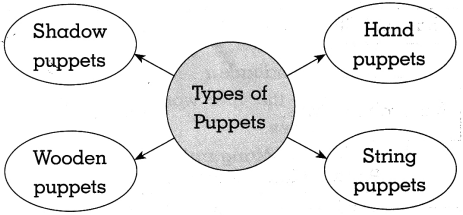
![]()
(2) Saints who popularised Bhajans:
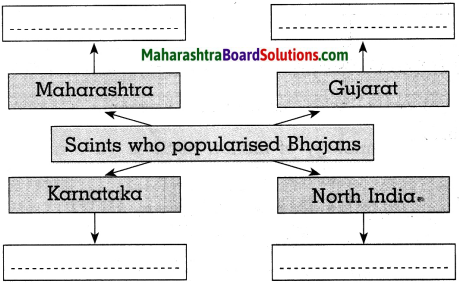
Answer:

(3) Plays by famous Playwrights:
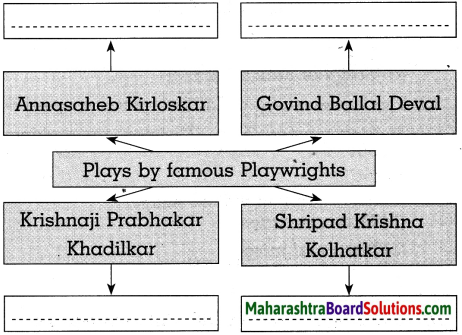
Answer:
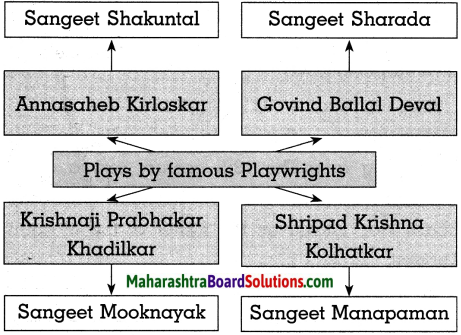
(4) Saints who popularised Bhajans in North India:
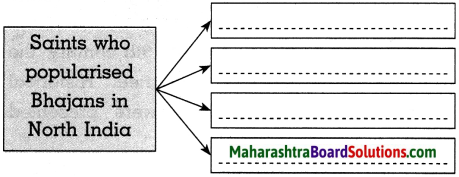
Answer:
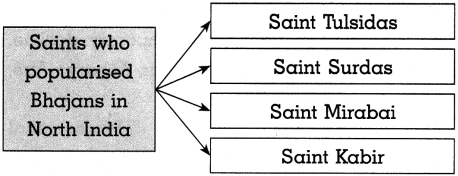
![]()
(b) Prepare a flow chart on the development of Marathi Theatre:
Answer:
Development of Marathi Theatre:
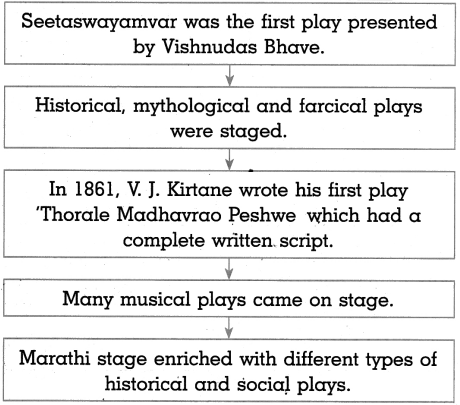
Question 9.
Explain the concept:
(1) Dashavatara Theatre:
Answer:
- The stories presented in Dashavatara shows are based on the ten incarnations of Vishnu.
- The method of acting, make-up, costumes in Dashavatara show is set by the tradition.
- It is mostly a musical show but there may be a few spontaneous dialogues.
- At the beginning of the show, Sutradhar, the narrator invokes Lord Ganesha, for its successful run.
- Dashavatara is part of the folk theatre in Maharashtra which has its origin in mythological plays.
(2) Bhajan:
Answer:
- Singing songs in praise of God and chanting God’s name accompanied by instruments like taal (cymbals), mridangam, pakhavaj is known as Bhajan.
- Bhajan is an important element of devotional music for those who are on the path of devotion.
- Varkari sect made Bhajans accessible to all.
- There are two types of Bhajans, Chakri and Songi BhajAnswer:
- Devotees keep moving in circular fashion and without break in Chakri Bhajan.
- In Songi Bhajan, singer-actors act as devotees and deliver dialogues in the form of devotional songs.
(3) Bharud:
Answer:
- Bharud can be described as a metaphorical song that has spiritual and ethical lessons. Bharud is similar to road show.
- Bharud is popular because of its wide range of subjects, humorous presentation, dramatic quality and easy rhythm.
- Bharuds are composed with the purpose of educating people on various aspects of life.
- Even though Bharuds of Saint Eknath are famous, bharuds were composed by many saints including Saint Dnyaneshwar.
(4) Keertan.
Answer:
- Keertan involves oratory, singing, acting, dancing and story telling.
- Naradmuni is assumed to be the founder of Keertan tradition.
- It is pure glorification of god. It is also a medium to educate the masses about good values of life and very purpose of human life.
- There are two parts in Naraadiya keertan Poorvarang and Uttarrang. Poorvarang comprises of Naman.
- Nirupanacha Abhang and Nirupan; Uttarrang comprises of narration of a story to illustrate the main theme.
- Keertan has two traditions in Maharashtra – Naraadiya and Varakari.
![]()
(5) Documentaries: (You would like to know this: Textbook page 44)
Answer:
- A film which gives information, inspires and educates people and is a short film is a documentary.
- Documentaries were made on freedom struggle, national leaders, social issues and superstitions, forts, animal species, sports, etc.
- They were aimed at creating public awareness about various issues.
- They are shown in the cinema theatres before the start of the main movie.
Question 10.
Write short notes:
(a) Means of Entertainment:
Answer:
- Entertainment is an integral part of man’s life. Man has developed many means of entertainment since ancient times.
- Ancient times saw the rise of festivals, fairs, sports, dance-music, etc.
- The means of entertainment changed with times.
- Television, mobiles, video games and movies and such other modem means of entertainment were introduced.
- Folk music, classical music, plays, books, newspapers, magazines are some mediums of entertainment which are available. Different types of sports, hobbies and travel too are means of entertainment.
(b) Lalit:
Answer:
- Lalit is an old form of entertainment popular in Konkan, Maharashtra and Goa. It belongs to the tradition of Naaradiya Keertan.
- It is presumed that the presiding deity is present on the throne. It is invoked by the people as it is widely believed that the deity fulfils all the wishes.
- Stories of Krishna, Rama and of great devotees are presented during the performance.
- Lalit forms a part of the backdrop of modem Marathi theatre.
(c) Keechakvadh: (Do You Know? Textbook page 43)
Answer:
- Krishnaji Prabhakar Khadilkar wrote Keechakvadh in the pre-independence era. It was a metaphorical drama.
- It was based on the incident of Keechakvadh described in the epic, Mahabharata.
- Draupadi represented helpless Mother India, while Yudhishthira represented the moderates and Bheem the extremists.
- Keechak represented the insolent Viceroy Lord Curzon.
- The audience used to perceive characters in this fashion and feel* enraged about the imperialistic British rule.
(d) Natashmrat: (Do You .Know? Textbook page 43)
Answer:
- The renowned author-poet Vishnu Waman Shirwadkar, also knpwn as Kusumagraj wrote Natasctmrat.
- It is styled after Shakespeare’s well known play ‘King Lear’.
- Ganpatrao Belvalkar, the tragic protagonist of Natasamrat represents a blend of two well-known personalities of early Marathi stage Ganpatrao Joshi and Nanasaheb.
- The traits of both great actors are found in the main character of Natasamrat.
- Natasamrat is a tragic story of an aging actor who gives his entire wealth to his sons and is humiliated by them.
- This play was very popular and created history on stage performance and in playwriting.
![]()
(e) Tamasha (Folk theatre):
Answer:
- Tamasha is a Persian word which means a pleasing sight. Tamasha emerged as an independent form in the 18th century absorbing the traits of folk theatre and classical arts.
- Tamasha is classified into ‘Sangeet Bari’ and ‘Dholakicha Phad’. Dance and music are more important than drama in Sangeet Bari. Tamasha with drama as main part was developed later. It included Vag, the dramatic part a little later.
- The show begins by singing the praise of Lord Ganesha, known as Gana. It is followed with the presentation of Gavalan.
- The second part of Tamasha presents the Vag. The plays like ‘Vichchha Mazi Puri Kara’ or ‘Gadhavache Lagna’ were very popular.
Question 11.
Explain the following statements with reasons:
(a) Puppetry is an oldest form of entertainment.
Answer:
- Puppet show was an important form of entertainment.
- The remains of clay dolls have been found in the excavations at the archaeological sites of Harappa, Egypt and Greece civilisations.
- Information on puppets is found in the texts like Mahabharata and in Panchatrantra stories.
- The ancient text Mahabharat has a mention that puppetry was one of the 64 arts.
(b) Vishnudas Bhave is known as the Father of Marathi Theatre.
Answer:
- The origins of the Marathi theatre can be traced to Dashavatara tradition. Lalit forms a backdrop of Marathi theatre.
- Seetaswayamvar, the first play, written and presented by Vishnudas Bhave was very successful.
- The movement of stage plays started by Vishnudas Bhave was followed in Maharashtra by historical, mythological and also light farcical stage plays.
- The farcical plays dealt with social issues in a humorous way. Therefore, he is known as the Father of Marathi theatre.
Question 12.
Answer the following questions in 25 – 30 words:
(a) Make a list of various types of entertainment and classify them into different categories. (Try to do it: Textbook Page 39)
Answer:
- Entertainment can be classified into two categories, active and passive.
- Active entertainment means an individual’s mental-physical participation. In passive entertain-ment, a person may not be an actual participant.
- To play cricket is active form of entertainment but to watch a cricket match is passive entertainment.
- To participate in festivals, fairs, celebrations is active entertainment but to watch as audience is passive entertainment.
(b) Write about Dashavatara form of folk theatre.
Answer:
- The stories presented in Dashavatara are based on the 10 incarnations of Lord Vishnu.
- The method of acting, make-up, costumes in Dashavatara shows is set by the tradition.
- The show is mostly musical but sometimes there may be a few spontaneous dialogues.
- The characters representing gods use wooden masks. At the start of the show, the sutradhara invokes Lord Ganesha.
- The show ends by breaking dahihandi, followed by aarati, praising the God.
- This is part of folk theatre in Maharashtra.
- Dashavatara shows are presented in the regions of Konkan and Goa after the harvesting season is over.
![]()
(c) What is required to be a Keertankar?
Answer:
The following qualities are required to be a Keertankar:
- A Keertankar also known as Haridas or Kathekaribuva needs to be very well informed.
- He should have wide experience and knowledge of the world.
- He should be well-versed in mythological and social subjects.
- He needs to train himself in qratory, singing, musical instruments, dance and humour. .
- He should dress in a traditional way.
(d) Write about the contributions of Bhosale family to drama.
Answer:
- The Bhosale family of Tanjore were successors of Chhatrapati- Shivaji Maharaj. They were patrons of arts.
- The rulers of the Bhosale family encouraged dramas in Marathi and in southern languages.
- Some of them have written a few plays and also translated Sanskrit plays.
(e) What is the contribution of Vishnudas Bhave and V. J. Kirtane to Marathi theatre?
Answer:
- Vishnudas Bhave presented the first play, Seetaswyamwar, on stage. Initially no written scripts were used for plays. Only the lyrics were written and dialogues were spontaneous.
- The movement started by him was followed in Maharashtra by historical, mythological and also light farcical stage plays. He is known as the Father of the Marathi theatre.
- V. J. Kirtane was the first author who wrote the script of Thorale Madhavrao Peshwe in 1861 and its printed copy was made available.
- It was the beginning of the tradition of having a complete written script ready before staging the play.
(f) Explain the nature of Rashtriya Keertan.
Answer:
- During the independence movement, a new type of Keertan was developed known as Rashtriya Keertan.
- It is performed in the same way as Naradiya Keertan.
- It placed more importance on creating awareness by narrating the life stories of great leaders of the Indian independence movement, scientists, social reforms, etc.
- Dattopant Patwardhan of Wai started Rashtriya Keertan.
Question 13.
Read the following passage and answer the questions:
(a) Who presented the play ‘Seetaswayamvar’?
Answer:
‘Seetaswayamvar’ was the first play presented by Vishnudas Bhave.
(b) Who wrote the musical play ‘Sharada’?
Answer:
Govind Ballal Deval wrote the musical play Sharada.
(c) How can plays bring about social awakening?
Answer:
- As theatre is an audio-visual medium, it creates a strong impact on the audience.
- They commented on evil customs, traditions, superstitions in our society. This started the reformation process.
- Sharada, a musical play, written by Govind Ballal Deval shed light on the evil custom of marrying young girls to aged men in a humorous style.
- ‘Ekach Pyala’ by Ram Ganesh Gadkari made the society aware about the evil effects of drinking.
![]()
Question 14.
Answer the following questions in detail:
(a) Write about the art of Puppetry.
Answer:
- The Kathputali is a traditional art of puppetry which has two styles.
- One that developed in Rajasthan and the other in South India.
- In ancient India, materials like wood, wool, leather, horns and ivory were used to make puppets.
- The role of the narrator known as Sutradhar is very crucial in stage show.
- The stage for this puppetry show is very small but the puppeteers use light and sound effects in an ingenious way.
- Shadow puppets, hand puppets, string puppets and wooden puppets are used in Kathputali shows.
- The artists who perform Kathputali shows are found in Uttar Pradesh, Maharashtra, Rajasthan, Telangana, Karnataka and Kerala.
(b) Write about the development of Indian film industry.
Answer:
- Cinema is a medium that brings together art and technology. With the advent of the technology of motion pictures the film industry came into being. It gave rise to the era of silent movies.
- The technology of sound recording paved the way for talkies. Dadasaheb Torane, A. P Karandikar, S. N. Patankar and V. E Divekar made the movie Pundalik with help from foreign techniciAnswer: This was a great step in the development of the art.
- Dadasaheb Phalke made a full length movie, completely processed in India. He made silent movies and documentaries also.
- Baburao Painter’s cousin, Anandrao Painter made the first cine-camera. Baburao Painter made many historical movies and a movie on realistic social issues. Bhalaji Pendharkar made movies invoking nationalist sentiments.
- Kamalabai Mangarulkar was the first woman producer, who made movies in Marathi as well as Hindi.
- Prabhat Film Company made many religious, historical, mythological and social movies. Production studios like Bombay Talkies, Rajkamal Productions, R. K. Studios, Navketan played significant role in development of the Indian film Industry. Period from 1961 to 1981 is the golden period of Indian film industry.
Question 15.
Identify the given picture and write about his contribution:
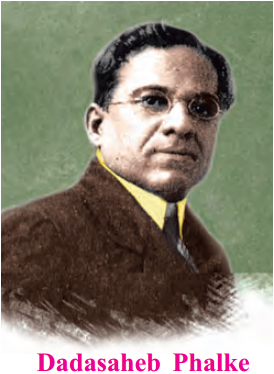
Answer:
- The given picture is of Dadasaheb Phalke who is known as the Father of Indian Film Industry.
- He released the first movie ‘Raja Harishchandra’ in Mumbai in 1913. He directed the movie which was entirely processed in India for the first time.
- He made silent movies named as Mohini- Bhasmasur, Savitri-Satyavana.
- He also made documentaries on the rock cut caves of Verul and pilgrim centres of Nashik and Tryambakeshwar. Later, he made historical and mythological movies.

- The Government of India has honoured him by instituting Dadasaheb Phalke Award given for lifetime contribution to cinema, which is considered one of the most prestigious awards.
10th Std History Questions And Answers:
- Historiography Development in the West Class 10 History Questions And Answers
- Historiography Indian Tradition Class 10 History Questions And Answers
- Applied History Class 10 History Questions And Answers
- History of Indian Arts Class 10 History Questions And Answers
- Mass Media and History Class 10 History Questions And Answers
- Entertainment and History Class 10 History Questions And Answers
- Sports and History Class 10 History Questions And Answers
- Tourism and History Class 10 History Questions And Answers
- Heritage Management Class 10 History Questions And Answers